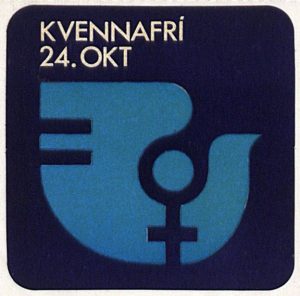Today’s This Day In History celebrates Iceland’s women when, in 1975, ninety percent — 90% (!) of them — went on strike from LIFE — and struck a big win in the fight for equality. They refused to engage in wife-ing and parenting and working and cleaning and cooking and caregiving. They called it Women’s Day Off.

The impact of the incredible collective action of Iceland’s women can’t be overstated:
Many industries shut down for the day as a result. There was no telephone service and newspapers were not printed since the typesetters were all women. Theatres shut down for the day as actresses refused to work. The majority of teachers were women so schools either closed or “operated at limited capacity.” Flights got cancelled since the flight attendants did not come into work and bank executives had to work as tellers to keep the banks open on this day. Fish factories were closed since the factory workers were primarily women. . . Employers prepared for the day without women by buying sweets, pencils, and paper to entertain the kids who would be brought into work by their fathers. Men were forced to take their children to work and feed them since all of the daycares were closed. As a result, sausages, a popular meal, sold out in many stores that day.
25,000 of those bad-ass striking women took to the streets. And five years later, Iceland elected the first woman “in the world to be democratically elected as a head of state.” And, according to a 2015 report, “the country recently topped the U.N.’s Global Gender Gap Report for the sixth year in a row. It’s no wonder the Nation named Iceland “the most feminist place in the world.”

To put what Iceland’s women did in perspective, there were 157 million women in the U.S. in 2010. If ninety percent of us went on strike like Iceland’s women did, then that would mean 141 million of us would refuse to engage in life, all together, to make the point about how indispensable we are to everything. 141 million of us. And, like the 12% of women who descended on Iceland’s capitol city of Reykjavik, 19 million of us would need to march on Washington.
Iceland’s women were #notplaying.
And this isn’t just something in the history books. Although Iceland made great gains for women, Iceland’s women still make 17% less than men (which means they are doing better than we are here in the U.S.). So what do Iceland’s women do? They went on strike again, of course!
So let’s take a moment to celebrate the undeniable bad-assness of Iceland’s women. We could all learn a lesson or two from their example!









